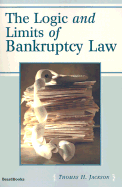|
|
|
|
||||||

|
The Logic and Limits of Bankruptcy Law
By Thomas H. Jackson 2001/10 - Beard Books 1587981149 - Paperback - Reprint - 296 pp. US$34.95 Provides insight and analysis of the fundamental principles of bankruptcy law and their application to bankruptcy problems. This book will prove interesting reading to bankruptcy attorneys, other attorneys, business persons, and those fascinated by the interplay between economics and policy. Publisher Comments This book sets forth a careful analysis of the fundamentals of bankruptcy law as well as informed insights into the subject. The author's premise is that there is an intellectual coherence that underlies bankruptcy law and that its first or underlying principles are few and elegant. These principles can then be developed by defining their potential operation in the existing social, economic, and legal world to identify precisely what bankruptcy law should encompass, how it can accomplish its goals, and the constraints on its ability to do so. The purpose of the book is to suggest what the underpinnings of bankruptcy law should be and then to apply that learning to a variety of issues while testing the existing bankruptcy law against them. The book is designed to prod analysts to think about these underpinnings in analyzing bankruptcy problems. From the back cover blurb: This books sets forth a careful analysis of the fundamentals of bankruptcy law. It provides a keen insight into the subject. The author's premise is that there is an intellectual coherence that underlies bankruptcy law and that its first or underlying principles are few and elegant. Bankruptcy law can be used to keep firms in operation, and bankruptcy law inevitably touches other bodies of law. These principles can then be developed by defining their potential operation in the existing, social, economic and legal world to identify precisely what bankruptcy law should encompass, how it can accomplish its goals, and the constraints on its ability to do so. The purpose of the book is to suggest what the underpinnings of bankruptcy law should be and then to apply that learning to a variety of issues while testing the existing bankruptcy law against them. The book is designed to prod analysis to think about these underpinnings in analyzing bankruptcy problems. This books will prove interesting reading to bankruptcy attorneys, other attorneys, business persons, and those fascinated by the interplay between economics and policy.
From Turnarounds and Workouts, January 15, 2002 The Logic and Limits of Bankruptcy Law is clearly the culmination of a long career of reflective attention to overriding issues and trends in bankruptcy. In it, Thomas Jackson presents a theoretical framework on which bankruptcy law is built, and emphasizes the need for a workable theory on what bankruptcy law can and should do. Problems in bankruptcy cases, he believes, are resolved too often in an ad hoc manner because the field of bankruptcy analysis lacks the discipline of determining if and why such problems are proper concerns of bankruptcy law to begin with. The objective of The Logic and Limits of Bankruptcy Law is to "show why bankruptcy's principal role limits what other functions it can usefully perform. " Mr. Jackson explores the idea that bankruptcy law has become more controversial because its scope has been extended beyond its mandate. Bankruptcy law's original, historical function is debt collection. Indeed, bankruptcy law is principally "an ancillary, parallel system of debt collection law," and provides creditors with a compulsory and collective forum to sort out their relative entitlements to a debtor's assets." Since the 1980s, according to Jackson, it has become "...fashionable, for example, to state that keeping firms in operation is a goal of bankruptcy law. It is likewise fashionable to see bankruptcy law as embodying substantive goals of its own that need to be "balanced" with (among others) labor law, with environmental law, or with the rights of secured creditors or other property claimants... (I)ncluding too much in bankruptcy law can undermine what everyone agrees it should be doing in the first place. Mr. Jackson allows that bankruptcy law historically has had a second role as well: to provide for "some sort of a financial fresh start for individuals." He devotes the tenth chapter of this book to his views on the difference between a financial fresh start for individuals and a financial fresh start for corporations. The first nine chapters of The Logic and Limits of Bankruptcy Law deal with the question of how assets in a bankruptcy case are to be used. The goal, Mr. Jackson says, should be "to permit the owners of assets to use those assets in a way that is most productive to them as a group in the face of incentives by individual owners to maximize their own positions." Bankruptcy law should concern itself with converting ownership of assets from debtor to creditor and reducing the cost of said conversion. Throughout his book, Mr. Jackson applies his theoretical framework to a variety of pertinent issues while testing the current provision of the Bankruptcy Code. These issues include determining liabilities and the basic role of non-bankruptcy law; redefining liabilities (the basic trustee avoiding powers of section 544); determining the assets available for distribution; executor contracts in bankruptcy; prebankruptcy opt-out activity and the role of preference law; running bankruptcy's collective proceeding; timing the bankruptcy proceedings; reconsidering reorganizations, and the scope of discharge and exempt property. The Logic and Limits of Bankruptcy Law will prove enlightening and thought provoking to the lay reader and business person interested in the interplay between business, economics, and policy, as well as to the bankruptcy professional with a desire to distinguish forest from tree.
|
|
|
|
home
| about us
| contact us
| related
sites |